This post may contain affiliate links.
A common question for many folks considering the RV lifestyle is affordability. Specifically, what is the cost of RVing? And what about full timing vs part-time RVing? After owning four RVs over the last eight years, we dish out the details on how our costs of RVing added up to give you an idea.
This summary post gathers all our information from six years of full-time RVing, plus two years of part-time RVing, and all four RVs that we’ve owned. We’ll break out comparisons and give you as much detail as possible to help you make informed decisions for your RVing adventures.
Plus, there’s a quick links section to jump forward to the areas you are most interested in. But there’s a lot of great and meaty stuff in here. So we recommend you read the entire post and thoroughly research before making an expensive purchase.
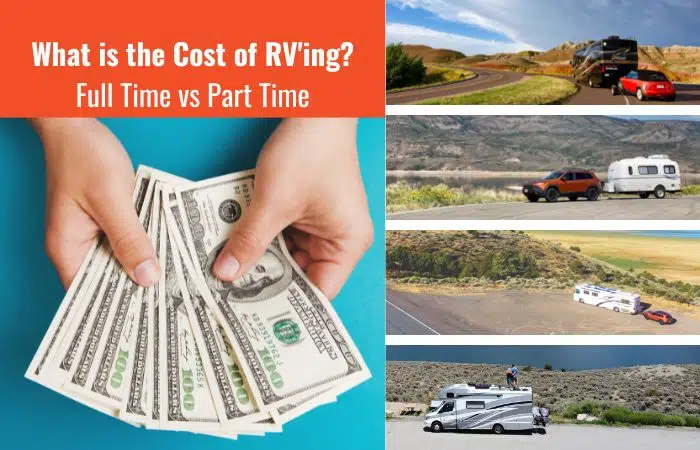
Costs of RVing Are Variable
A list of possible RV costs and expenses that you need to be aware of is one thing. But actual, hard data is another. Because this report is based on our six years of full-time RVing plus two years of part-time, it is not just theory or guesses but real-world RV ownership.
We have documented our expenses and created a total and average monthly RV cost for you. Importantly, we also provide context, as RV-related expenses can (and will) vary depending on your unique situation, rig, and choices. Not all of the decisions we made will be the same as yours.
For example, we have predominantly been RVing in motorhomes, not trucks and trailers. Our full-time RV travel was all in Class A motorhomes towing a car, knowing this is typically a more expensive option than buying a trailer. While we did RV part-time initially with our Jeep and a small Casita camper trailer, we went back to a small Class C motorhome.
Have there been some costly surprises? Yes! But we take responsibility for ALL of the choices we make in our RV lifestyle. And you should too. That’s where doing your homework (like reading this post) comes in.
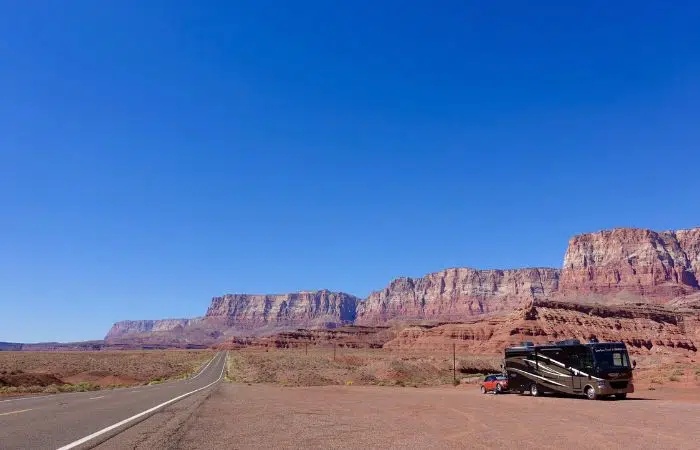
Full time RV life vs traditional life with part time RVing
As full-time RVers, many of your RV-related expenses replace what you might have otherwise spent on your stick-and-brick home – whether you own or rent. When looking at our part-time RVing data, remember that those costs are in addition to all of the costs associated with our home base. Costs of your home base will vary widely depending on the type and size of your home and where it is located. Many of your costs will essentially double up across your home base and RVing expenses.
Since this post is about the costs of RVing, we will only be including RVing-related costs. If you are trying to support both a home base AND an RV, be sure to add both of those costs into your budget.
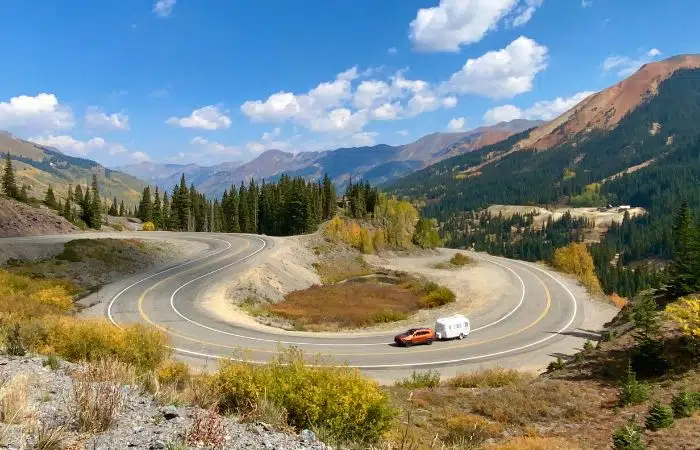
Disclaimer:
Before we begin, remember that every RV and every RVer is different. So our historical RV costs and expenses may be similar or significantly different to what yours are or might be in the future. There is no right or wrong – just different scenarios and different related costs, which may or may not be typical.
We share our personal information as a helpful guide, but it is not a hard and fast rule of what to expect. Always do your research. Contrary to what many saw in 2020 and up to around mid-2022 – with many RVs often selling at full price or even higher than the original purchase price, RVs are almost always a depreciating asset. So do not overcommit yourself financially when buying an RV. Go in with your eyes wide open so that you are prepared for any outcome. You just never know when the market may turn, which is what we’re seeing in recent months.
We hope this article provides you with an excellent perspective and understanding and helps guide your own RV purchase and ownership decisions. Please read it in detail to the end to get the complete picture. There are many variables to consider, even in our situation shared here.
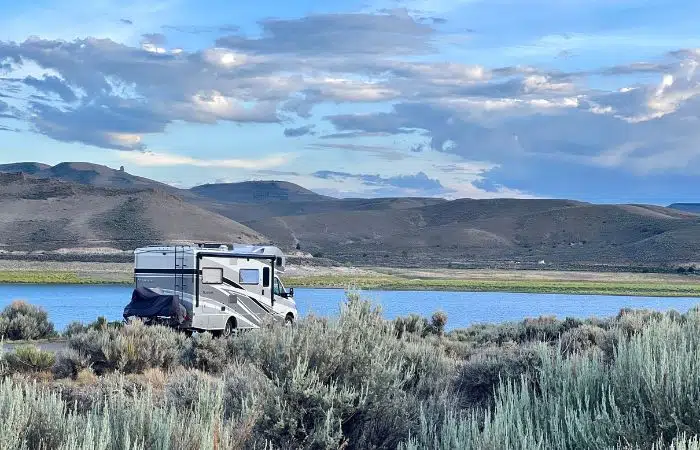
What Costs of RVing Are Included?
This article is a very comprehensive summary of our costs of RVing. With costs for both full-time RVing and part-time RVing. Additionally, we have even more detailed supporting articles that we will link to, for deeper dives into the specifics.
This post includes the following for all four of our RVs.
Quick Links to Sections Of This Post
- The Four different kinds of RVs we have owned
- Cost of RV purchase and financing
- RV Maintenance and repair costs
- Depreciation costs of RVing
- Cost of RVing campground stays
- Fuel Cost of RVing
- Other Hidden Costs of RVing
- Comparison of our part time and full time costs of RVing
- Cost of RVing Table – bringing all the information together
- Summary and where to find more detail about RVing costs
The Four RVs we have owned
As mentioned above, we have owned and traveled in four RVs since May 2014. When full-timing, we had two Class A motorhomes (a gas and a diesel) that we used for multiple years each. For part-time RVing costs, we reference our small towable camper trailer and a motorized Class C RV. Here is a little snippet of information about each to keep perspective on the data that follows.
First, our full-time RVs
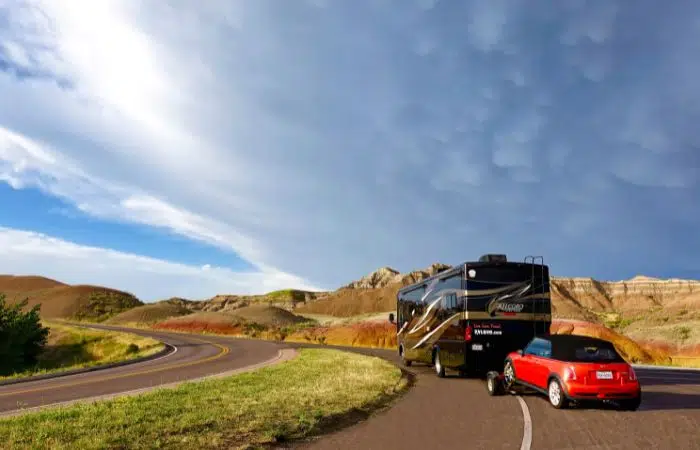
2012 Tiffin 35QBA – 35′ Class A gas motorhome
We purchased this newer gas-powered, 4-slide, Class A bunkhouse Tiffin motorhome from a private party in 2014. It was two years old with 23,000 miles on it when we bought it. This was the RV we launched into full-time RVing with. We lived, worked, and traveled in this RV full-time for almost four years and converted the bunkhouse into an office. Take a look here.
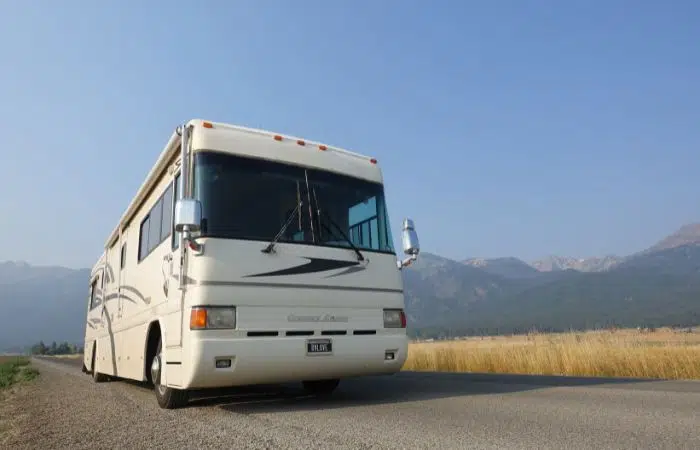
1999 Country Coach Intrigue – 40’ Class A diesel motorhome
In March 2018, we purchased this RV from a dealership. This much older Class A diesel pusher motorhome had a single slideout, over 200k miles on the odometer, and needed an Ultimate RV Makeover. We lived, worked, and traveled full-time in this motorhome for about two and a half years. Take the original tour of it here.
Next, here are our two part time RVs
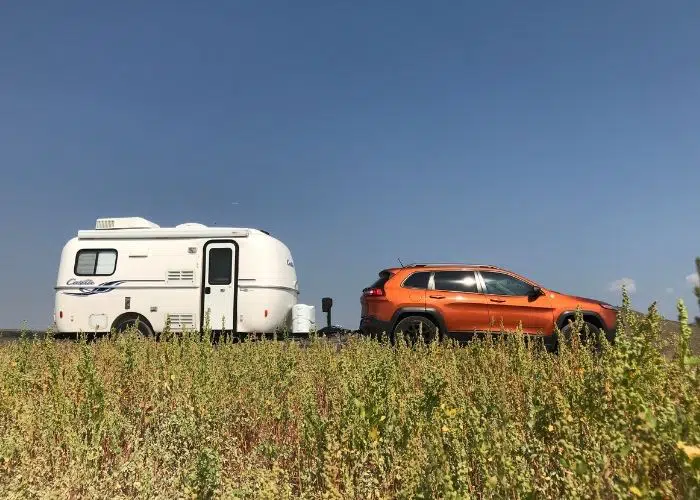
2019 Casita Freedom Deluxe – 17’ fiberglass travel trailer
This cute little towable camper trailer (no slides) was purchased in July of 2020 while we still had our big Country Coach motorhome. We did some part-time travel with it while we still had the big coach. Then we kept the Casita for part-time RVing after we bought a home base and sold the big motorhome. We towed this 17’ fiberglass camper behind the Jeep Cherokee Trailhawk we previously towed behind our Class A motorhomes. You can watch our Casita camper tour here.
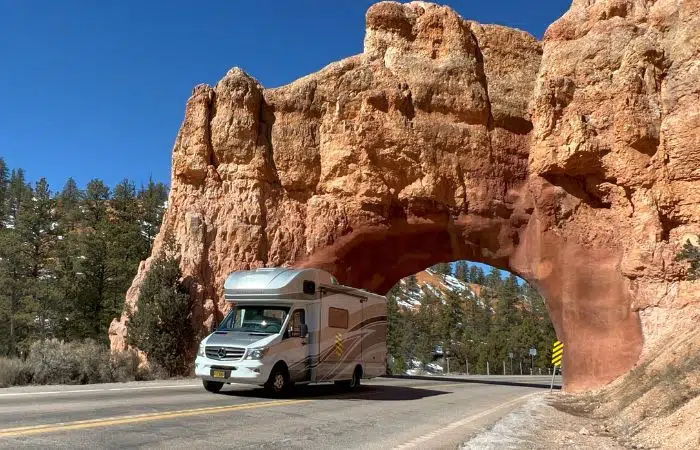
2017 Winnebago Navion – 25’ Class C mini motorhome
We bought this Mercedes Sprinter chassis Class C diesel RV from a friend in early 2022 after renting it for an 8,500-mile test drive on our RV road trip to Florida. You might be surprised at how much this RV has cost in the short time we have traveled in it. Especially considering it is only used for part-time RVing travel. More about our Class C motorhome and a quick tour here.
2021 East to West Tandara fifth-wheel and 2009 Ford F250
We bought this truck and trailer in the fall of 2023. The details of these costs are not currently included in this post, but we plan to update this post in the second half of 2024 once we have enough data on our newest RVing setup. In the meantime, you can read up on the truck and trailer in these posts.

Costs of RVing Purchase and Financing
First off, how much did it cost to purchase our RVs? The purchase price, tax, registration, and interest expenses are included below for all four RVs. We do a much deeper dive into the financing costs of our full-time RVs in our related post on the Real Cost of RV Ownership here.
Our Full time RVing purchase and finance costs
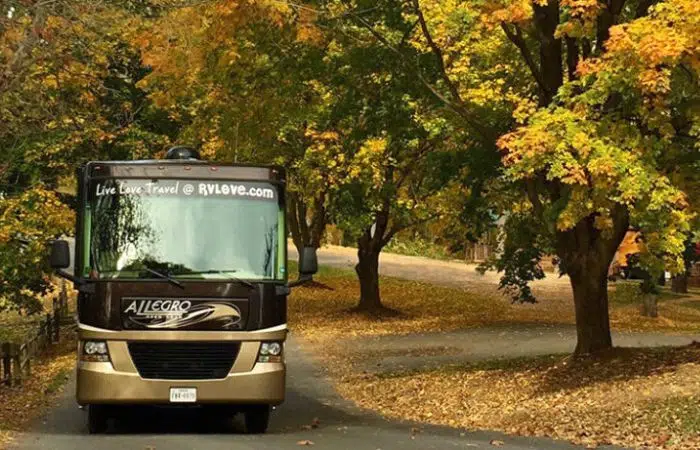
2012 Tiffin 35QBA – 35’ Class A gas motorhome
All up, we paid about $100,000 in 2014 ($93,000 plus Colorado state taxes and fees of $7,000). The MSRP was $129,500 (ex. tax). We financed it with a 20-year loan at 4.39% with payments of $569 per month.
The interest cost alone on our RV loan totaled $13,740 in less than four years. That is an average of around $305 per month. If we had kept this RV and loan for the entire term, the total interest would have, of course, been far more.
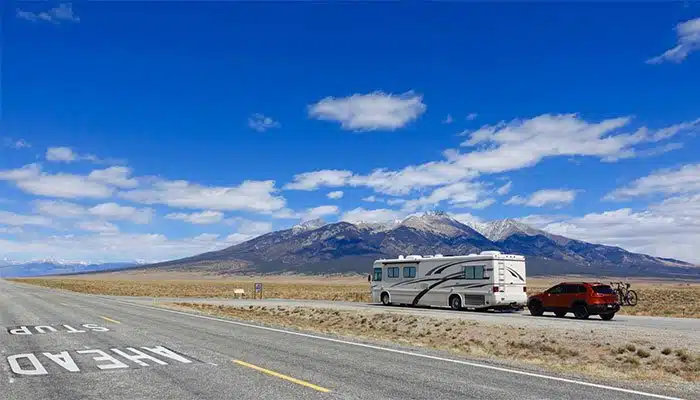
1999 Country Coach – 40’ Class A diesel motorhome
Bought at the bottom of the depreciation curve and being very educated buyers in a relatively perfect storm for getting the best deal, we only paid $25,000 for this coach in 2018. With taxes and fees, we invested $26,500. These coaches were nearly $250K when new, back in the last millennium! That would have been the equivalent of around $340K when we bought it in 2018.
We opted to take out a seven-year, unsecured loan at 5.44% from Lightstream because it was so easy. We got immediate approval, and the funds hit our account within a couple of days so we could make a fast purchase. Being unsecured, this also (importantly) meant we immediately got the RV title as if we had paid cash. This is very valuable when you sell.
Monthly payments for this RV loan were $501 per month. Being a similar interest rate but a much smaller loan value and much shorter length term than the first loan, only $140 per month of that was for interest. The total interest expense paid for the two-and-a-half years we owned the coach was around $4,200.
Our part time RVing purchase and finance costs
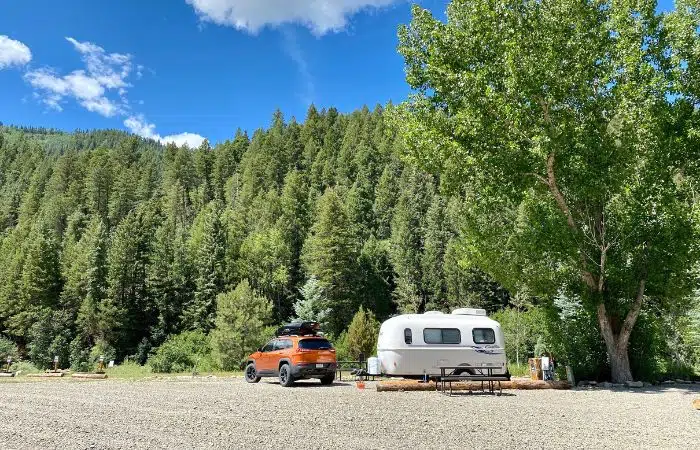
2019 Casita Freedom Deluxe – Travel trailer
Purchased in July 2020, near the beginning of the RV buying frenzy caused partly by the pandemic, we paid $25,000 (plus $1,030 in taxes and registration). This was a fully loaded model. Used prices were about the same as new at that time because there was a 14-month wait on new units.
We paid cash for this RV. So we did not incur any financing/interest costs on it. Some may argue that by paying cash, we missed out on the opportunity of earning revenue from investing that money. But we won’t be adding in those calculations.
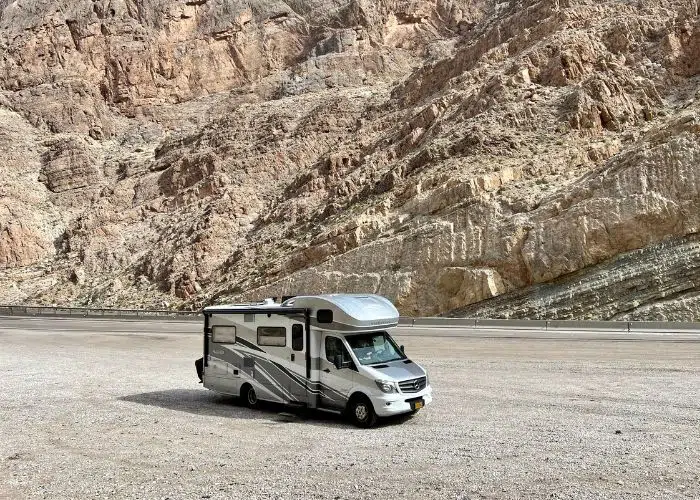
2017 Winnebago Navion – Class C diesel mini motorhome
We started off renting this RV from a friend for 3.5 months at the mate’s rate of $1,200 per month. But $1,800 of that was paid in repairs and upgrades. We will include more on those repair costs later. So we will consider the rental cost as being only $2,400 for the sake of this article.
Then we purchased the RV in early 2022 for $80,000. This was an excellent price because the original owner, who was a friend, knew it needed some repairs and didn’t want to deal with the hassle of selling it. Fortunately, it was also before the many interest rate hikes.
We had a twelve-year unsecured loan – again through Lightstream – at only 4.79%. Our loan value is $85,000, so our monthly payment was $777 per month. Approximately $345 of the payment (just less than half) went toward interest. Being an unsecured loan, we had the title in hand – a huge advantage when it came time to sell.
Between the rental and finance expenses, we spent $6,195 ($2,400 in rent + interest of $345 x 11 months). Taxes and registration fees for this RV were $3,043, bringing the new total to $9,238.
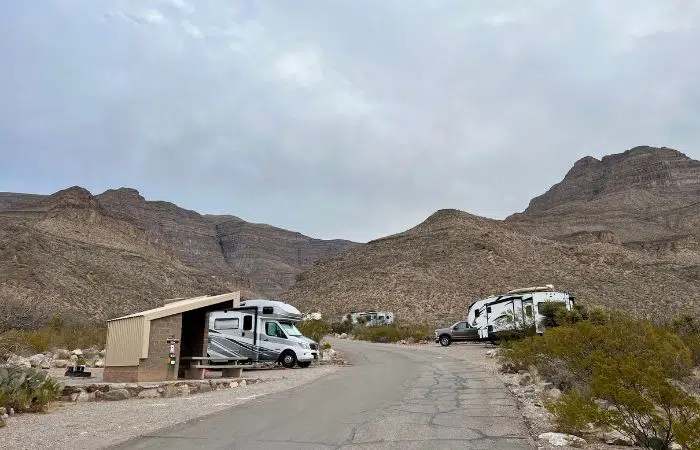
Purchase and Financing Costs of RVing summary
As you can see in the two more expensive RVs we bought, the interest cost really adds up. Those two RVs each had interest payments of over $300 per month. And both of those loans were in times of low-interest rates. With today’s rates, interest costs would be much higher. Paying cash for our less expensive little travel trailer kept that cost of ownership down substantially.
Remember that, generally, RVs depreciate pretty hard. Keep reading as we share more specific information on depreciation below. But paying interest on a depreciating asset can really get some buyers into financial trouble, quickly owing more than the RV is worth. Please remember that and don’t over-invest or overcommit yourself financially when making any RV purchase.
We do a much deeper dive into all of the financial costs of our full-time RVs in our detailed report: The Real Cost of RV Ownership.
Now let’s take a look at RV repairs and maintenance.
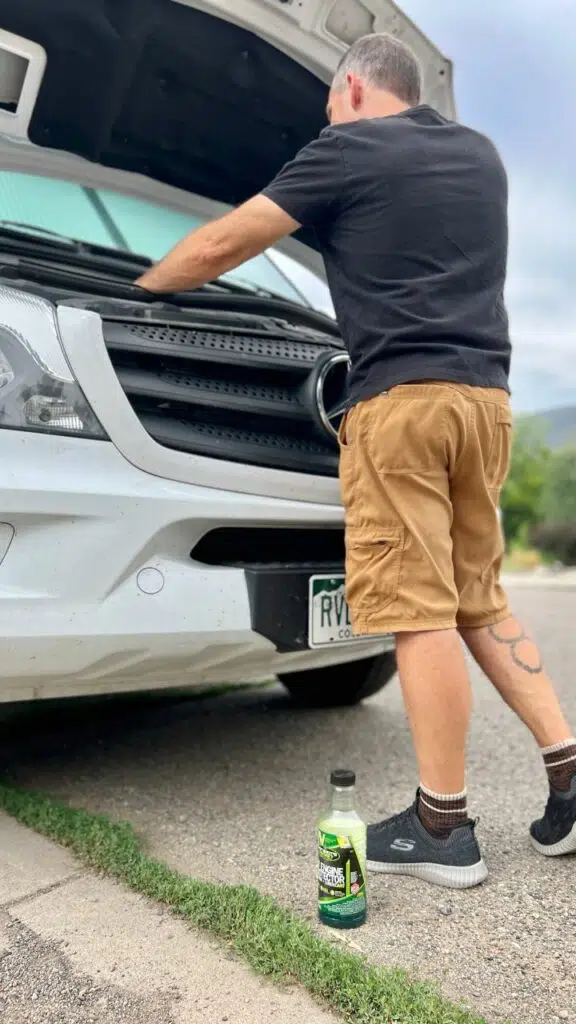
RV Maintenance and Repair Costs
As most people who have done some research know, all RVers need to plan for having some repairs and maintenance costs when RVing. Some RVs are better than others. But you should always plan on needing to make repairs, even on brand-new RVs.
RVs are NOT like new cars that are usually relatively trouble-free for years after purchase. In fact, many new RVs need more fixes than a gently used and well-maintained pre-owned RV, as every new RV has a ‘seasoning period’ where the first owner has the honor and fun of ‘working out the bugs.’
A good way to manage and budget for unexpected expenses is by having an RV extended warranty. We’ve had one of these on three of our four RVs – our Country Coach did not qualify due to the high mileage.
Learn more: RV Extended Warranties – are they worth it?
Let’s dive into our costs of RV maintenance and repairs over the last eight years. Hold onto your hats. There are some doozies in this section.
Maintenance and RV repair costs for our full time RVs
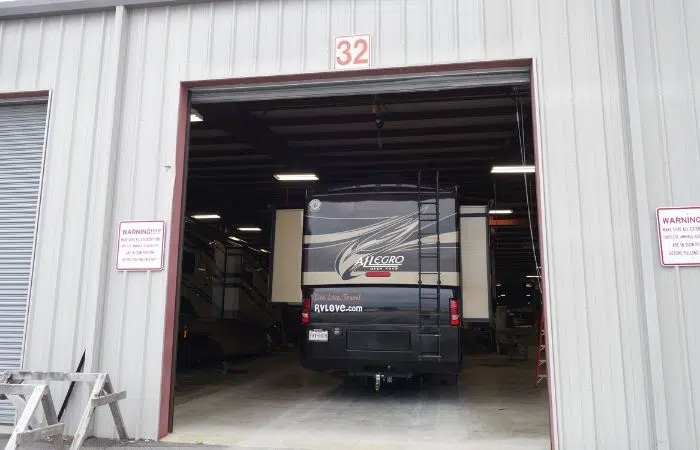
2012 Tiffin 35QBA – Class A gas motorhome
At only two years old and very well maintained – both by its previous owner and by us – one would expect this coach to be pretty low cost. But our total cost of RV maintenance and repairs came to $17,981. Remember, that was for nearly four years of full-time RVing.
We had an RV extended warranty which covered $5,721 of repairs. So our out-of-pocket expense was $12,260, which included a set of 6 brand-new tires and a suspension upgrade. That is an average of $272 per month out of pocket. Or about $400 per month if you include what the RV extended warranty covered (i.e., if you did NOT have an extended warranty).
We were lucky in that the previous owner was able to transfer his RV extended warranty to us. So, we only paid the nominal transfer fee. Between the RV repairs we made and the previous owner, this RV’s extended warranty was well worth the cost in this case. Looking back now, this RV was actually pretty reliable. And while still expensive, the cost actually looks pretty good compared to our next RV. Check it out.
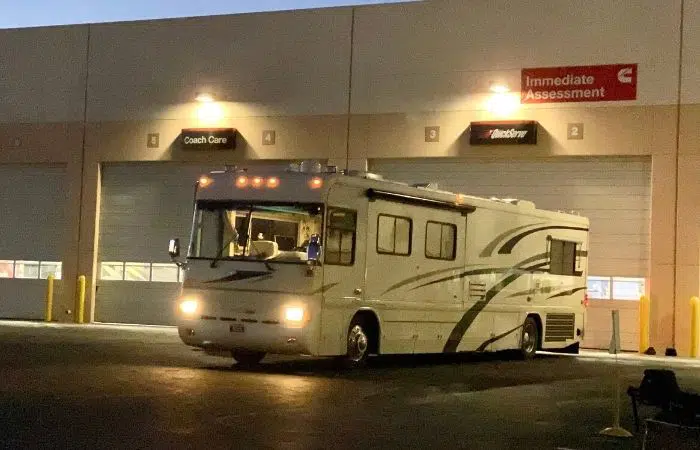
1999 Country Coach Intrigue – Class A diesel motorhome
Being a much older diesel coach and based on our pre-purchase RV inspection, we knew when we bought this RV ‘as is’ for $25K (the original price on the lot was $50K) that it would need some work. Fortunately, after a few years of RVing, being a handy guy, and doing many RV factory tours, I felt confident enough to do most of the work myself.
This includes our Ultimate RV Makeover – you can read all about our off-grid RV renovation and also watch the 8-part YouTube video series here.
Drum roll, please…
In the 30 months we owned this coach, we spent over $24,000 on RV repairs and maintenance! That is an average of $800 per month. OUCH! Remember that I did most of the RV repairs myself, DIY-style. If we had paid an RV repair shop rate of $120 per hour, the total would have been many thousands of dollars higher. One repair alone – the diesel fuel pump – accounted for around $9,000. And it’s the only rig we have not had an RV extended warranty on to help cover big and unexpected repair costs.
Also, that $24,000 number does NOT include optional RV upgrades. Like the ones we did in our RV makeover, the lithium battery and solar upgrade, the new awning fabric, and other improvements we made. Those other improvements were about another $28,000, again with next to no outside labor cost.
We have a TON more detail on the specific RV repair, maintenance, and upgrade costs for our six-year full-time RVs in our in-depth Real Cost of RV Ownership report here.
Maintenance & RV repair costs of our part time RVs
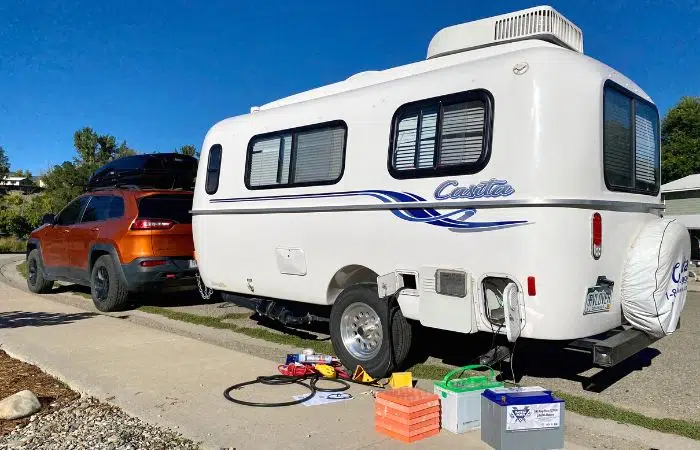
2019 Casita Freedom Deluxe – towable travel trailer
Our Casita was a great tiny RV with virtually no issues in the 16 months we owned it. We had an extended warranty for it, which cost around $2k, but we never used it. About half of the warranty cost was refunded when we sold the Casita.
The only two minor and inexpensive repairs were a water tank leak that I fixed myself with JB Weld and the replacement of a few broken rivets. The water tank leak was caused by super high water pressure at a campground on our first trip. This could have easily been avoided if I’d brought my water pressure regulator!
Knowing us, we also did some upgrades on the Casita. These include replacing the single lead acid battery with a new 100AH Battle Born Battery, a battery monitor, a 2000-watt Honda generator, and ceramic window tint. The total value of these items was about $2,200, which came back to us when we sold the RV at a higher price, and we sold the generator separately.
Other related purchases included $281 for a brake controller for our Jeep and $216 for an electrical surge protector. After paying tens of thousands of dollars in repairs and upgrades on our previous RV, it was terrific to pay less than $50 total in actual RV repairs during the 16 months we owned the Casita.
We also spent a little on maintenance supplies for packing the bearings and winterizing the RV. Repairs and maintenance costs on this RV are $1,050 ($1,000 for unreimbursed warranty plus $50 in hard costs). The Casita was the newest, smallest, and most straightforward of all our RVs. But we also used it far less as it was too small for extended RV trips (for us, anyway).
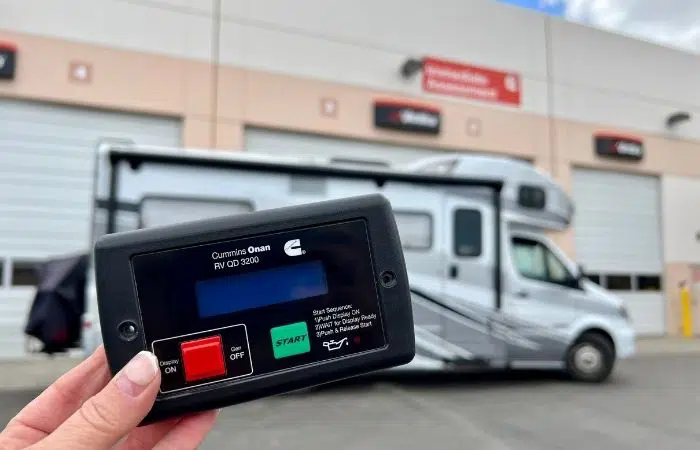
2017 Winnebago Navion – Class C diesel motorhome
In the short 15 months we rented/owned and traveled in this RV, our repairs and maintenance costs have actually been pretty high. Fortunately, I have been able to do many of the repairs myself, saving some labor costs. Total so far has been $9,515. That equates to $634 per month.
But, some of the repairs and maintenance were big-ticket, long-term items like six new Michelin tires ($1,316). We also needed to replace two completely dead lead acid house batteries. So we went with two new Battle Born 75ah group 24 lithium batteries ($1,450). The Mercedes Sprinter chassis RVs require scheduled maintenance every 20,000 miles, and our most recent service cost $3,051. Other notable repairs were for the diesel generator, $906, plus some roof leak issues, totaling another $600 or so.
We are very confident that we now have this 6-year-old RV very dialed in. So we expect the costs of RV repairs and maintenance to hold at this number for quite a while. That would bring down the monthly average over time. But it was indeed a tough start for an RV that is relatively new with 40K miles. And an even more difficult pill to swallow when it is only our part-time RV.
We are not living in it full time and, therefore, still have our home base costs on top of this. Fortunately, this RV also has an RV extended warranty (with zero deductible) that was transferred from the previous owner. So any other potential significant repairs should be covered, for a while at least.
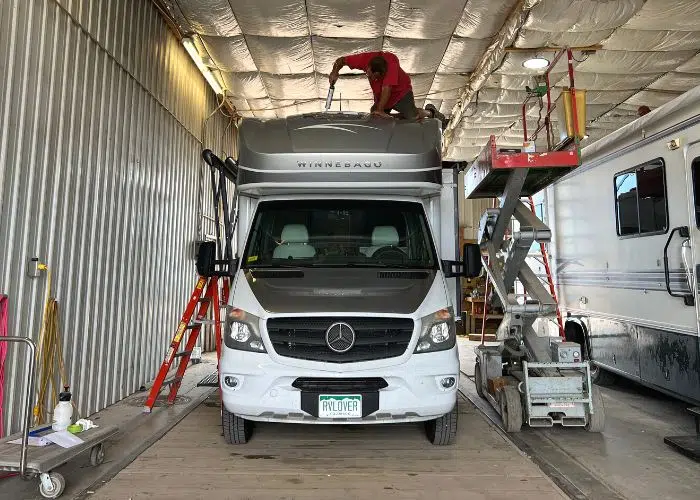
RV Maintenance and Repair costs of RVing summary
Let’s total up all of those repairs from over the years. In the 108 months counted across all four RVs, the total amount we spent on RV repairs and maintenance is $52,546! Over eight and a half years that is an average of about $5,832 annually, or $486 per month.
Time to pick yourself up off the floor.
Remember, this also includes A LOT of free labor from our friends and me. And it does not include most of the optional RV upgrades. This is just the RV repairs and maintenance, with a few upgrades to higher quality items during a required repair. The bottom line is that an RV’s repairs and maintenance costs can add up quickly. And they absolutely need to be a part of your budget.
Remember, this is just a summary post. So if you want to do a deeper dive into the specifics, we have a TON more detail on our RV repairs and maintenance costs for our six-year full-time RVs in our detailed Total Cost of RV Ownership post here.
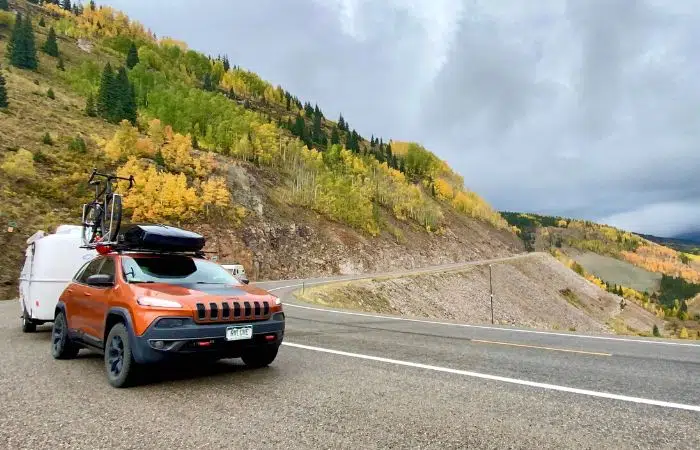
Depreciation Costs of RVing
Those who watched RV prices – both new and used – soar throughout 2020, 2021, and even early 2022 might presume that RVs hold their value reasonably well. But historically, most RVs depreciate pretty hard, especially when new.
Depreciation isn’t something many RV buyers give enough thought to before buying. In the excitement of buying an RV, it can be easy or convenient to overlook the fact that you will likely sell your RV for a LOT less than what you paid.
We also cover the subject of depreciation in Chapter 3 of our book “Living the RV Life: Your Ultimate Guide to Life on the Road.” And we strongly encourage you to factor in estimated depreciation on your RV when budgeting for it.
Evidence shows the RV market has cooled substantially. And it continues to be slow in 2024, returning to the pre-pandemic ‘normal.’ So you should plan on seeing RV values drop back down from this point forward. Let’s take a look at our depreciation costs of RVing for the rigs we’ve owned.
Depreciation costs of our full time RVs
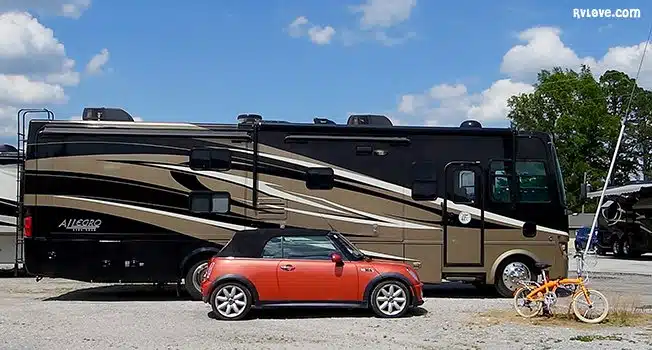
2012 Tiffin 35QBA – Class A gas motorhome
Being a relatively new RV when we bought it, you might expect this RV would have significant depreciation. Fortunately, we bought it from a private seller at a reasonable price, avoiding the most significant initial drop. And we were lucky to be able to sell the RV to a private party instead of trading it in at an RV dealership.
You may recall that we bought it for $93,000, but paid $100,000 including taxes and registration fees. Almost four years later, when we considered trading the RV in at a dealership, we were only offered $50,000! But we sold it to a private party for $75,000. That’s a HUGE difference!
That $25,000 in depreciation we experienced while we owned this motorhome equals $556 per month. If we had accepted the dealer trade-in price it would have doubled to an average of $1,111 PER MONTH! Depreciation is real, folks. Don’t make the mistake of ignoring it when budgeting for your RV purchase and the total cost of ownership. You must consider the estimated selling and purchase prices to get the complete picture! And do consider the ‘worst case scenario’ to protect yourself.
Remember that this coach was our full-time home and mobile office for almost four years.
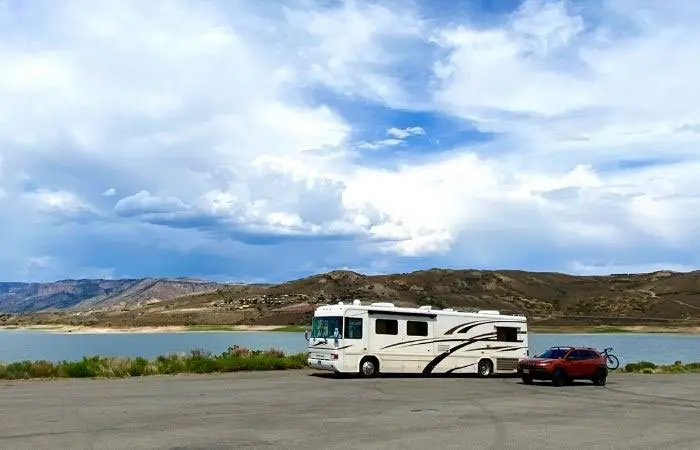
1999 Country Coach Intrigue – Class A diesel motorhome
After the massive depreciation learnings on our first RV, we sought to minimize that on our second full-time coach. As mentioned above, we bought our Country Coach at the bottom of the depreciation curve at $25,000 ($26,500 all-in) and at an excellent price. But we (and the dealer) also knew it needed money spent on it right away, like new tires on the same day we bought it!
We sold this motorhome 30 months later in a VERY hot seller’s market (summer of 2020) for $49,000. But we had also done a complete RV renovation and spent about $28k on upgrades and improvements to this coach. So we had about $54k invested in it. The coach looked fantastic – especially on the inside – and had an incredibly powerful off-grid system with 600AH of lithium batteries plus 1,020 watts of solar.
If you count our renovations and upgrades, the actual depreciation we experienced came to about $5,000, or an average of $166 per month.
Also, remember that this does NOT include necessary repairs, just the optional upgrades. It also does not include the 600+ hours of ‘free’ labor we (and our friends) poured into making those improvements. If we were to put a dollar value on time invested, then the depreciation cost of this RV would have been substantially higher.
Again for context, this motorhome was our full-time home and office while we traveled the country. We consider the amount we spend on full-time RVing to be comparable to paying rent.
Depreciation costs of RVing for our part time RVs
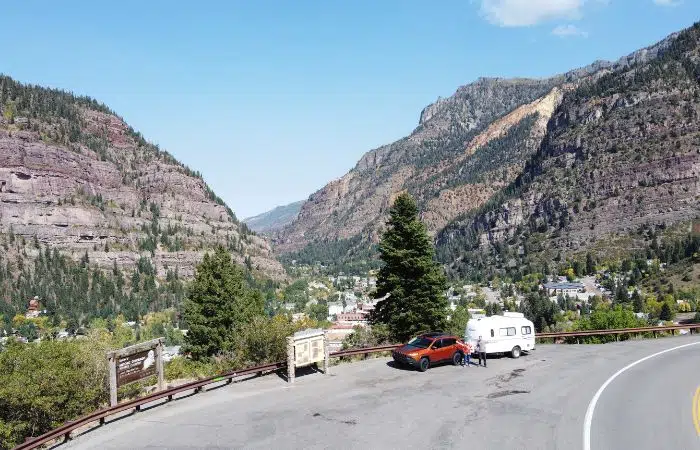
2019 Casita Freedom Deluxe – towable travel trailer
You might recall that we bought our Casita at the beginning of the RV buying frenzy for $25,000. Well, that frenzy continued into 2021, and we sold it 16 months later for $29,900. We had made a couple of upgrades, including our lithium battery. But we still made a few thousand dollars profit on this RV. Even after you factor in the taxes, registration fees, minor repairs, and insurance, we still made money on this RV. This is a very rare situation of appreciation in the RV space.
Context: these fiberglass campers are simple, well-built RVs and tend to hold their value very well. And honestly, we actually didn’t use our Casita a whole lot as it was so small. We only went on a handful of shorter trips, compared to living and traveling full-time (as we did in our Class A motorhomes). So the miles and overall usage were a LOT lower.
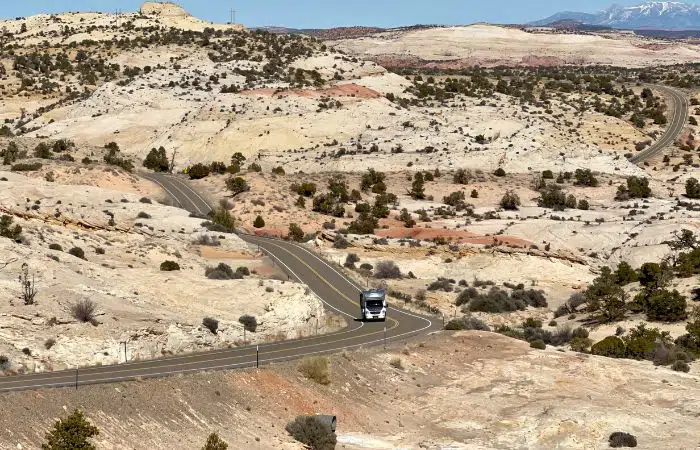
2017 Winnebago Navion – Class C diesel mini motorhome
Having only bought this RV in the spring of 2022 and buying it from a friend at a good price, we did well with depreciation costs on this RV too. The RV market had cooled by the time we sold it, but Class B and small Class C RVs were still the most robust segment then.
After doing comparison shopping and getting a professional appraisal, we sold this RV for $92,000. But we must also factor in the $3,043 in taxes and fees. Plus, another $1,000 or so was spent on upgrades NOT included in the repairs and maintenance section above.
So our depreciation was actually an appreciation of $7,957. This is NOT to be expected or even remotely normal. We bought very well because of special circumstances and made upgrades and repairs that made the RVs worth more when selling.

Depreciation costs of RVing summary
Since the big hit on our first RV, we’ve been able to keep our depreciation costs at manageable levels. But a big part of that has been due to the timing (and luck) of the surge in RV prices over the last couple of years. As the market softens, RV depreciation will return to more typical levels.
RV buyers are often tempted by the long-term loans available for RVs. Since they have kitchens, bathrooms, and sleeping areas, many banks offer loans for 10, 15, and even 20 years. The low payments on these loans make the RV seem much more affordable than the reality. And you’ve likely seen RVs priced on dealer lots as a monthly payment amount instead of the actual cost.
But when the time comes to sell the RV, the depreciation cost will raise its ugly head, especially when considering the cost of financing. The numbers will be much worse if you decide to trade the RV in on another one, burying that loss into a new long-term loan. This is really just kicking the can down the road.
Our advice is to buy an RV you can afford. If financing, take out a shorter-term loan. And, of course, do your research to make sure you are getting a reasonable price. If you live in your RV full time, it may make sense to spend a bit more, but be cautious.
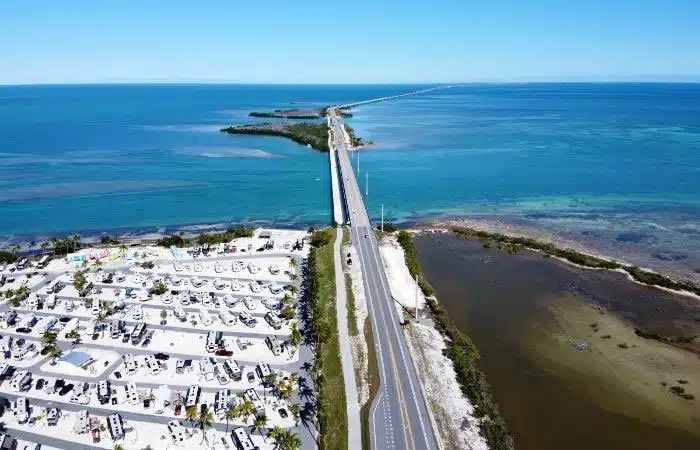
Costs of RVing – Campgrounds
One of the most significant expenses in RV life besides buying the RV, especially for full-time RVing, is where you stay. In this section, we will summarize our camping-related RVing costs. We have two related blog posts that dive into FAR more detail. See our total camping costs over our six years of full timing. And another that dives explicitly into the costs, savings, and an in-depth review of our Thousand Trails membership.
Campground costs are highly variable. We mix up our travels widely – from public campgrounds and private RV parks to membership campgrounds, high-end private resorts, boondocking, and more. Some nights we have paid over $180 (ouch!), and many nights we paid no nightly fee. We like to pay more attention to our overall average. So the totals below will be a good gauge if you plan to have a similar style of travel.
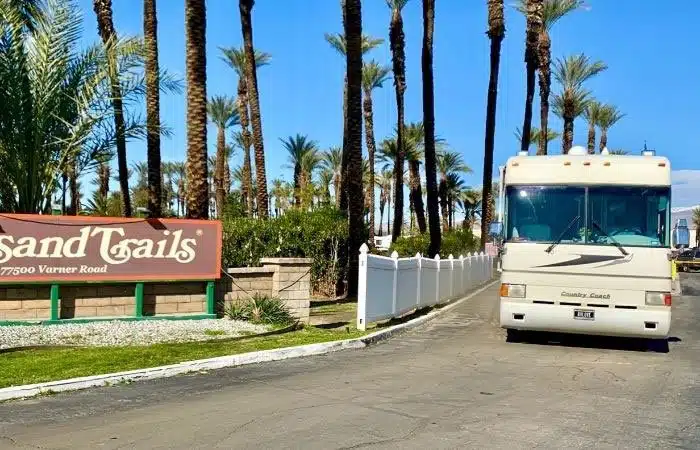
Camping costs for our full time RV life
The total of our six (ish) years of camping costs for our full-time RVing lifestyle was $34,145. This equates to $474 per month or $16.63 per night. With the average cost of a campground stay being $45 per night, our $16.63 number is pretty great.
Remember, we also made good use of our campground memberships and boondocking to offset some of our higher-priced stays. But our focus was not exclusively on saving money. We know people who spend thousands of dollars per month and others who spend less than $100 monthly. So this RVing-related cost can vary widely, depending on how you choose to do it.
Also, remember that we did full-time RV travel from 2014 to 2020. Since then, campground prices have increased across the board. But that doesn’t impact our stays at Thousand Trails or when boondocking.
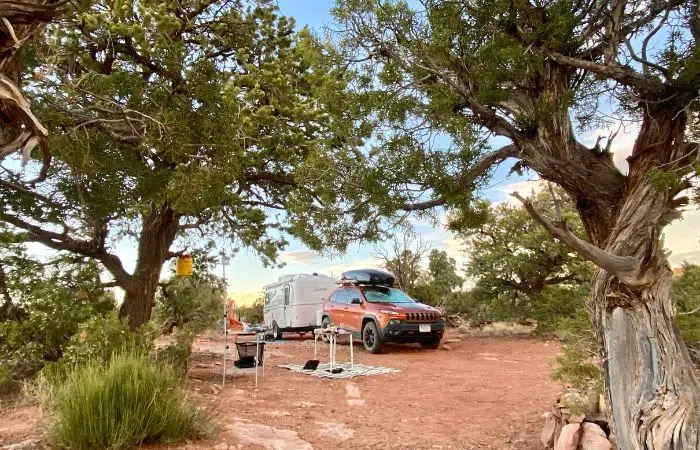
Camping costs in our part time RV life
We mostly did short trips with the Casita, and we didn’t actually use it that much at all. Our total days in it were only about 30. We still paid our annual campground membership dues that year, even though we didn’t use them much. So when you include those fees, our total camping costs were around $1,730 for an average of $58 per night.
We traveled far more in our Class C motorhome. When you include our campground membership fees, we have spent about $6,890 on RV camping, for an average of $36 per night.
Of course, with a much smaller percentage of time being spent in our part-time RVs, the total cost should be much lower than our full-time life. But our annual camping memberships don’t provide as much value with fewer stays in the system. This, in turn, raises our average nightly cost. Our average nightly camping cost, including membership fees, was $39 over the 30 months considered for this post.
Again, this is just a summary of our camping costs of RVing. We have shared enormous detail, breaking down how many nights we stayed in the various types of overnight stays year by year for our full-time RVing. You can find them in these blog posts:
What RV Camping Cost us over six years and 50 states of full-time RV life
Is Thousand Trails Worth It? A comprehensive review.
We did an 8,500-mile RV Road trip – what did it cost? How did we save?
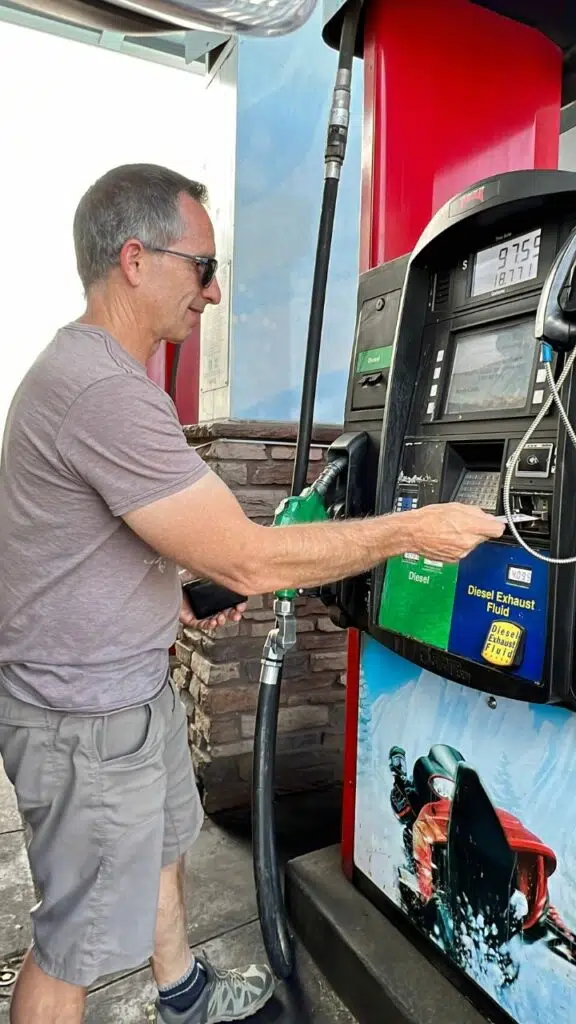
Fuel Costs of RVing
Fuel costs of RVing obviously vary widely, depending on how and where you travel. Sharing our summary totals will at least give you a gauge to work with.
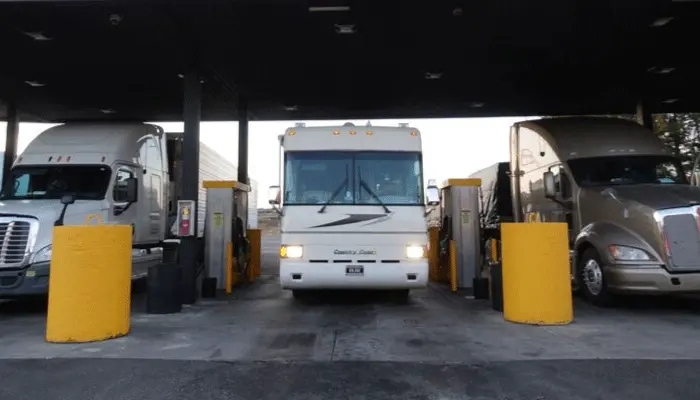
Our full time RVing fuel costs
For a detailed breakdown of our full-time RV living fuel costs, we suggest you check out our separate dedicated full-time fuel cost post here. But if you just want to get the big picture, we summarize it for you below.
In our six years of full-time RVing, we drove about 56,000 miles in our RVs, plus 51,000 miles in our towed vehicles. The average fuel economy of our RVs was around 7.5 miles per gallon. And the average mileage of our towed vehicles was 26 mpg. A combined average of a bit under 14mpg.
Fuel prices in those years varied widely but averaged around $3.50 per gallon. So our historical cost was around $27,000 in the 75 months of full-time RVing. This equates to around $360 per month. Average fuel prices are much higher now. At 2023 prices, this would have been closer to $550 monthly on average. And may have also slowed our travel pace.
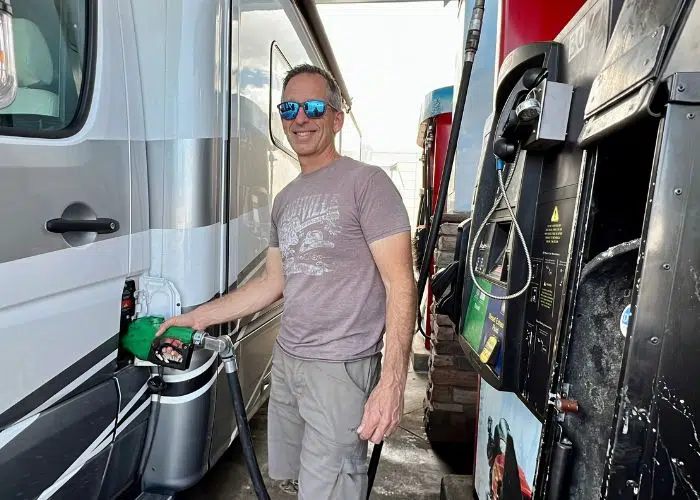
Our part time RVing fuel costs
Similar to other categories above, our fuel cost for RVing with the Casita camper was very low. Most of our travel was local or regional. We towed the Casita with our Jeep Cherokee Trailhawk, which got surprisingly good mileage towing the trailer (about 21mpg vs the high 20s, not towing). In the 16 months we owned the Casita, we towed it 2,219 miles. At 21mpg, that equates to 106 gallons. Fuel prices were averaging around $4 per gallon. So our total fuel cost was $425, or $27 per month.
In the 15 months we traveled in our Class C RV, we drove about 15,000 miles. Interestingly, that is many more miles than we traveled yearly in our RVs during full-time RV life. Most of this Class C travel was in 2022, with diesel fuel prices near $4.75 per gallon. We averaged around 14.4 mpg with this small diesel Class C motorhome. That equates to around 1042 gallons used for a total of $4,948. So our average fuel cost was $330 per month.
We share more detail about our fuel usage and other camping costs from our Class C travels in these posts:
We did an 8,500 mile RV road trip to Florida – here’s what it cost and how we saved
Busting 5 Common RV Camping Myths… with Proof!
When you combine our fuel costs for our two part-time RVs over the 30 months, it totaled about $5,400. That’s an average of $180 per month.

Fuel costs of RVing summary
As mentioned above, it was interesting to see such high mileage in our part-time Class C RV travels compared to our full-time RVs. There are two main reasons for that.
First up, when you have a home base, you leave and come back to the exact location. When you are full-time RVing, you don’t ‘go back.’
The second reason is the type of RV. Being a smaller Class C, we chose not to tow a vehicle, so we also used the RV for local exploring. When full-time RVing, we towed a separate vehicle for exploring areas.
Though our fuel costs might seem high to some, they were actually lower than what many families spend commuting to work and other errands. Remember, in our full-time RV life; we traveled to all 48 states in the RV. Fuel costs can vary greatly depending on your RV type and the distance traveled. And how you drive!
Here are a couple of handy posts that show you how you can save money on fuel in your RV life.
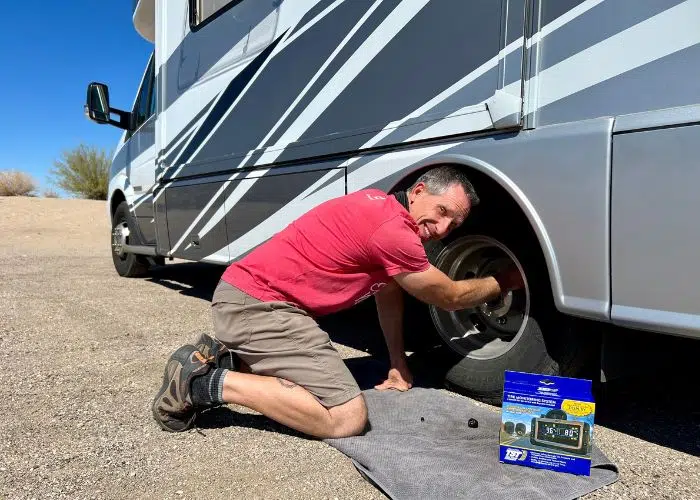
Other Hidden Costs of RVing
In addition to repairs and maintenance, which can be hard to predict, you should also budget for the other costs of RVing. Things like RV Insurance. Our RV insurance, when full timing, averaged around $100 per month.
Our part-time RV insurance averages less than $40 per month. Consider RV storage costs when it’s not in use unless you have space to park it on your property. We strongly recommend you get a professional RV inspection to reduce the likelihood of making a lousy RV purchase (whether new or used).
Also, consider investing in RV safety gear to stay safer while also avoiding expensive issues and repairs. We highly recommend getting a Tire Pressure Monitoring System (TPMS), an electrical surge protector, and a water pressure regulator. You will probably also need a brake controller when towing a trailer. Four-down towing equipment to tow a car behind an RV is convenient, but it can cost many thousands of dollars. Here’s our flat towing setup: part 1 tow bar and part 2 braking.
You should also consider the cost of your time. This is especially relevant if you work or run a business. And if you are significantly upgrading your RV or doing all your repairs and maintenance. Even consider the time it takes to bring the RV in and out of storage and pack and unpack before a trip. Of course, many of the above might be enjoyable to some RVers. Some love having projects, and prepping for a trip, and planning your travels, can be considered a fun part of your adventure.
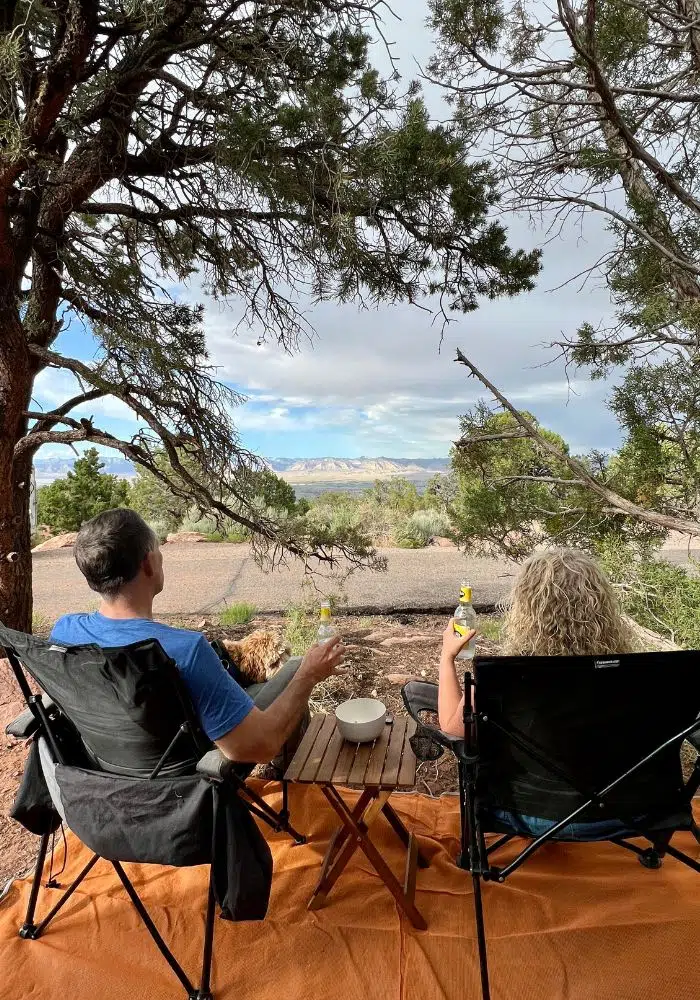
Comparison of Part Time vs Full Time RVing Costs
As we mentioned at the beginning of this post, full-time RVing and part-time RVing are very different lifestyles. The main factor is that part-time RVing means you have a separate primary residence with all those related expenses.
But we have also found comparing our related costs of RVing to be a fun, helpful, and often enlightening exercise. One that definitely gives a closer look into the costs, and this offers a lot more perspective.
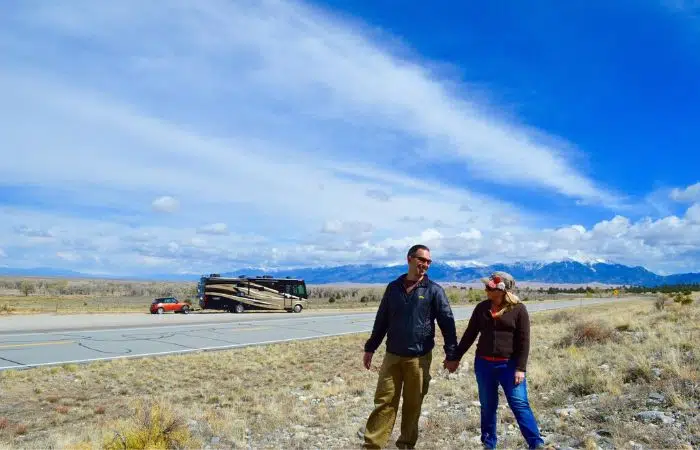
Our Full time total costs of RVing
For this total number, our RV-related costs of full-time RVing life include depreciation, repairs and maintenance, fuel, and insurance. That total was $125,600 for 75 months (2014-2020). This translated to approximately $1,675 per month.
When you add our average monthly cost for campgrounds of $474, the new total was $2,149 per month. Remember, that is on the lower side of average costs for camping as a full-timer. Some spend much less, but many spend much more.
Again, we share FAR more details about our full-time RVing life in our related blog posts. We will list them for you at the end of this post.
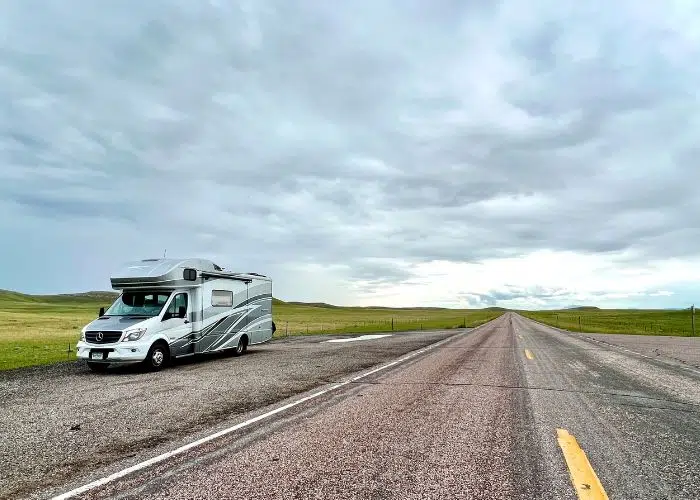
Our part time total costs of RVing
Towing our Casita camper with our Jeep was incredibly affordable RV travel. With ALL the above categories considered, it only cost us $2,305 for an average cost of $144 per month. Again, that is purchase-related costs, upgrades, depreciation, fuel, insurance, campground stays, and campground memberships. But we didn’t use that RV much. It mostly sat in storage in our garage.
On the other hand, when you add all those exact costs in for our part-time Class C RV they are MUCH higher. The total came to $18,186 ($26,143 minus $7,957 in appreciation) for an average monthly cost of $1,212.
Over time, that average monthly cost could go down as many of the costs were front-loaded. But that cost reduction could be offset by an increase in the depreciation cost.
That is still a significant number when considering that it is on top of our home base related costs.
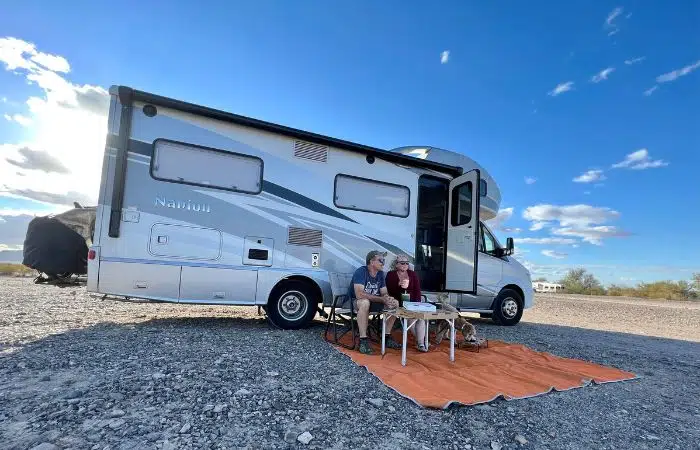
Costs of RVing Summary Table
The table below breaks down the highlights of the various RV costs information above into an easy-to-compare format.
Table notes for clarification:
- Depreciation in the table considers purchase price, financing cost, taxes, registration, and upgrades. Then subtracts the selling price.
- Fuel prices for the full-time RVs are based on prices at the time and would be much higher at today’s prices.
- Fuel and camping costs for full-time RVs are based on the full-time average multiplied by the number of months owned.
- Hidden costs include insurance, storage, and RV gear.
Cost of RVing Table
If viewing on a mobile device you may need to scroll to the right to see the additional columns.
| RV Cost Type | Tiffin | Country Coach | Casita | Winnebago |
|---|---|---|---|---|
| Purchase Price | $93,000 | $25,000 | $25,000 | $80,000 |
| Taxes and register | $7,000 | $1,500 | $1,030 | $3,043 |
| Finance and Interest | $13,740 | $4,200 | N/A | $6,195 |
| Upgrades | N/A | $28,000 | $1,000 | $1,000 |
| Depreciation | $25,000 | $5,000 | -$1,600 | -$7,957 |
| RV repairs and maintenance | $17,981 | $24,000 | $1,050 | $9,515 |
| RV Cost Type | Tiffin | Country Coach | Casita | Winnebago |
|---|---|---|---|---|
| RV Fuel Cost | $16,200 | $11,000 | $425 | $4,948 |
| Camping and memberships | $21,300 | $14,200 | $1,730 | $6,890 |
| Hidden costs | $5,000 | $3,500 | $700 | $500 |
| Total | $99,200 | $61,900 | $2,305 | $18,186 |
| Months used | 45 | 30 | 16 | 15 |
| Monthly cost | $2,205 | $2,063 | $144 | $1,212 |

Summary and Where To Learn More
So there you have it—a high-level view of over eight years of RV travel, including six full-time years. We hope you found some valuable information and insights in the information above. It has certainly been interesting for us to reflect on. Please keep in mind that there were many variables to the expenses above that could have a significant impact on what YOUR hard costs would be.
We have loved all four RVs and both RVing travel styles. It has also helped us continue to learn more to share with you and help you guide your RVing-related decisions, whether that is here on our website or in our two best-selling books, Living The RV Life and RV Hacks.
Even though the focus of this post is the costs of RVing, we also love looking at what RVing has given us over the years. We have enjoyed many wonderful experiences, made great friends, and earned a living doing what we love. How do you put a price on that? We look forward to continuing to travel in RVs and sharing with you.
Related blog posts you can enjoy
- What has RV camping cost us over 6 years of full time RV life
- Is Thousand Trails Worth it?
- The real cost of RV Ownership after 6 years of full time RV life
- How much have we spent on fuel over 6 years of full time RV life
- We did an 8,500 mile RV road trip to Florida – here’s what it cost
- Busting common RV travel myths
- Save money on fuel with these 7 fuel saving tips
- RV Extended Warranties – Are they worth it?
- Ultimate RV Makeover series
- How we chose our first RV (the Tiffin)
- Country Coach when we first bought it
- Casita camper trailer
- Winnebago Navion
Sign up for our email newsletter with the latest RV park reviews, news and updates.
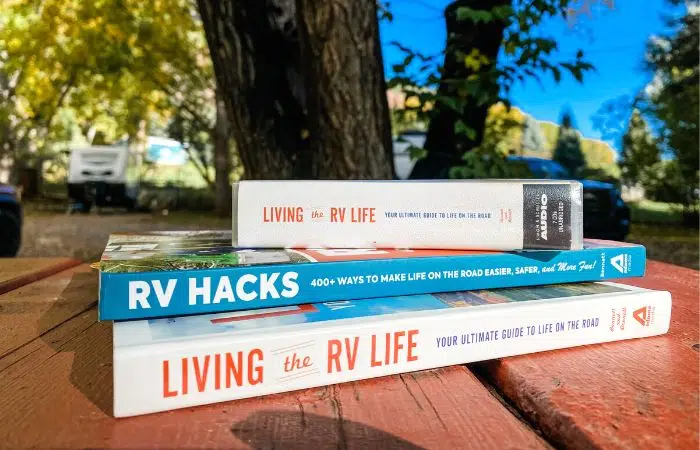
More Planning Content
Here are some other posts we think you will enjoy reading to learn more about RV living. Hover over the image to see the post title.

Values Of RVs. What’s My RV Worth?
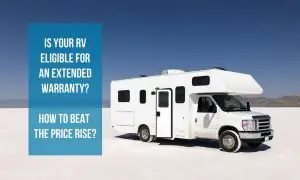
When to Buy an RV Warranty For Best Value
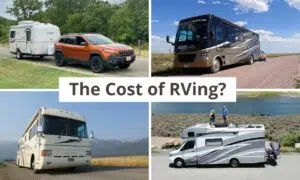
Cost of RVing – Full Time vs Part Time?
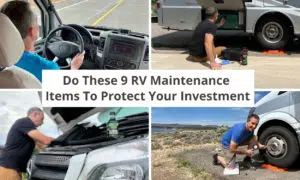
9 RV Maintenance Items To Protect Your Investment
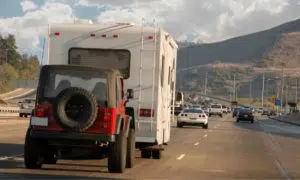
The State of RV Repairs: Problems, Solutions and On-Demand RV Techs

How To Winterize An RV: What You Need
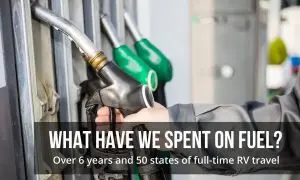
Fuel Costs Over 6 Years of Full Time RV Life
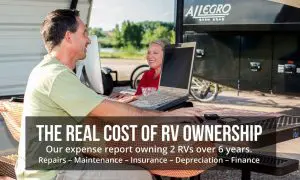
The Real Cost of RV Ownership. Here’s What We Spent.
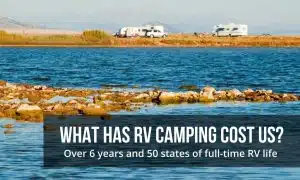
RV Camping Costs over 6 years of Full-Time RVing

Jeep Death Wobble Fix Update – How We Fixed It

11 More RV Repairs, Mods and Upgrades To Our Motorhome
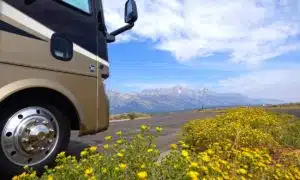
RV Extended Warranties. Are They Worth it? 2024 Update

Diesel Fuel Discounts – Save Money with This Fuel Discount Card
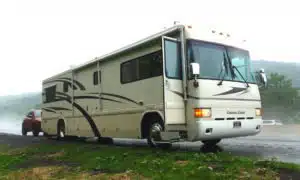
Something is Wrong! Our Death Wobble “Breakdown”
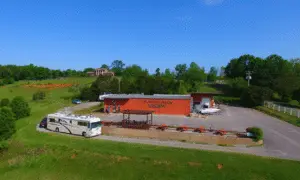
UN-Planning our RV Travels? We Did Something Different and Liked It
GOT COMMENTS OR QUESTIONS?
We would love to hear from you. Drop us a note in the comments section below.

12 thoughts on “Cost of RVing – Full Time vs Part Time?”
I’m very sorry to tell you this, but, in 66 months of ownership, the cost of a small diesel Class B motorhome… it’s about $1 per mile in repairs, maintenance and upgrades….. Some upgrades were just convenience and others for increased safety, so, if you want to deduct $14,000 off of that go ahead, but, it’s still a lot of money. Traveling in an RV is not a guarantee of cheaper travel.
We drove over 42,000 miles and this is the cost of owning an RV…..
So, this number below is not unusual…..
In the 30 months we owned this coach, we spent over $24,000 dollars on RV repairs and maintenance! That comes to $800 per month. Ouch.
Hi Mark, thanks so much for sharing your experience and cost of RV ownership! So few seem to really do that, and are able to look clearly at the numbers as you – and we – have done! A dollar a mile sounds like a good estimate actually, as a ballpark, for folks to plan for. And you are right, it’s not necessarily a guarantee of cheaper travel – so much depends on the rig, where you go, miles, and type of camping you prefer… so it can quickly get very expensive! We know folks at both ends of the spectrum, and plenty in between. RVing is more affordable when you aren’t also paying a mortgage and cost of running a home! But even then, people need to be aware of depreciation and such (like the opportunity costs of how else that money could have been spent/invested). $800 a month cost of ownership is OUCH indeed, especially if you weren’t full timing in it, and it was on top of your other home. Depending on how often you like to travel by RV, it may make sense to just do 2-3 a trips a year in a rental RV instead! Perhaps not the same in terms of style and comfort as having your own, but at least you aren’t responsible for the ongoing monthly expenses, repairs and maintenance! Nor storing it. Anyway, we really do appreciate you sharing your experience and hope you have many wonderful travel memories from your 30 months of travel in the Class B motorhome! Cheers – J.
Marc and Julie:
Thank you for the cost breakdown. Fantastic information.
We have been living full time in our 2018 Tiffin Phaeton 40IH for 3.5 years now, and have been tracking our costs as well. It is nice to compare costs and confirm that our costs are reasonable.
You have been one of the several full-time RV YouTubers who have helped and inspired us in taking our great adventure. The information you have provided – then and now – has allowed us to make this lifestyle choice much easier. We have jumped into the deep end of the pool knowing what we could expect our costs would be, and are comfortable that we made the right choice, for us.
One question though. Since you lived and worked in your RV’s full time, I assume you were able to claim quite a bit of your expenses and depreciation on your income taxes. Is that a savings that should be considered in the overall cost equation?
Keep up the great work.
Safe travels.
Ken and Corinne Glassman
@FollowingOurDreams
Hello Ken and Corinne,
Thank you for your kind words about our content over the years. Glad to hear our costs help you confirm reasonableness of your own costs.
As for your question on the expenses. Yes and no. Yes, we were able to claim some costs through our RV related business, but very few. Since we didn’t have a separate home base, our RV was our home. This disqualified it from many of the deductions we could benefit from now that we do have a home base. Perhaps we were being overly conservative with our claims during our full time life. It is an interesting question. But since we claimed so little over the years, and since the actualized benefit would be complex to account for, we don’t think it would be worth adding into this article for the full time RVs. Having a home base now, and having a business focused on RVing does allow more potential deductions than we had before. But since most people reading the post are unlikely to have a situation like ours, I will probably steer clear of including it because of so many variables based on individual cases, and especially since some might consider it tax advice, which we are not qualified to advise on. Thanks again for the question and compliments on what we have shared.
Don’t forget the cost of freedom to travel and do what you want to do. PRICELESS!
So true! Good to hear from you Sam! Cheers.
As always, an excellent, informative article. I appreciate your willingness to do the work to categorize the costs in a way that reveals the whole story. Eyes wide open!
Thanks, again!
Glad you enjoyed it! And appreciated the level of detail. As you said…. eyes wide open! Those who are well prepared will thrive. All the best and you are welcome!
Without a doubt, the most fair,factual and interesting review for those considering the RV life whether full or as part-timers. Well done, safe travels!
Thank you very much. We really appreciate you saying that. That was our intention. Thanks again and safe travels to you too. -M
This is by FAR, the most detailed, concise, honest, thorough and inclusive “Cost To RV” breakdown I have ever seen done. Wow,…….what a great resource you have provided for folks to read before taking the plunge! A person can “train wreck” their financial life if they don’t know all these things up front!
Thank you so much for that feedback. We really appreciate it, and hope that the article (and related posts with even greater detail) help a lot of people. Thanks again! -M